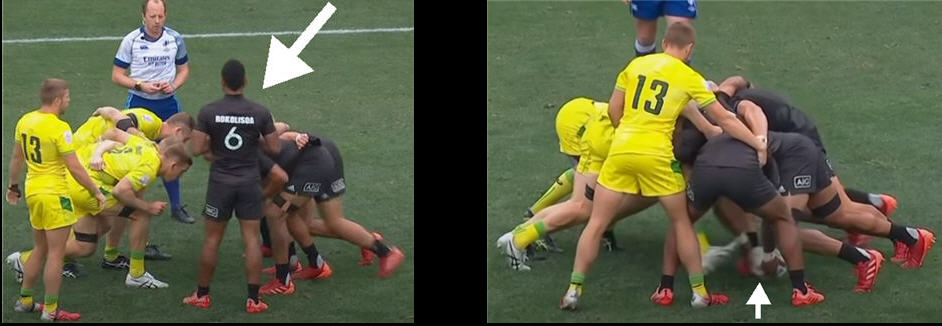This article looks at the position and role of the scrum-half in sevens rugby. Scrum-halves are also known as half-backs.
I’ve got some great pictures and video clips to illustrate the skills that a scrum-half needs to play in Sevens.
If you’re interested in the fifteen-player version of the sport, check out our article on the role of the scrumhalf in Rugby Union.
What Is A Scrumhalf In Rugby Sevens?
The scrumhalf in sevens rugby is one of the main playmakers on a team.
Scrumhalves feed the ball into the scrum and often throw into the lineout. They need excellent passing skills and are elusive runners.
They are the link between forwards and backs in attack and are often sweepers in defense.
Playmakers in attack
Both scrumhalves and flyhalves are the playmakers in sevens.
Playmakers organize and direct the team’s attacking flow. They aim to create situations where their team has more attackers in an area on the field than there are defenders.
The best place to direct attack is from the center of the field with both left and right options. The scrumhalf is often passing the ball to the flyhalf in a central position, who sets up the attacking play.
Sweepers in defense
When a sevens team is defending, most of the players will space themselves across the field as the first line of defense.
The sweeper covers the wide open space behind! In other words, this defender must be ready to sweep across the field from one side of the pitch to the other.
The sweeper must also be able to anticipate and recognize the opposition’s likely attacking move. This skill comes from the experience of directing attacks themselves.
This is why the scrumhalf is often the sweeper on a sevens team.
What Does The Scrumhalf Do In The Scrum In Sevens Rugby?
The left side of this picture shows the New Zealand scrumhalf waiting as the forwards start to pack down for the scrum.

The right side is a freeze-frame which captures him bending to roll the ball towards the hooker’s feet.
If you want to see a detailed breakdown of the skill of striking the ball out of the scrum, check out our article on the role of the hooker in sevens rugby.
Defending the scrum
The other thing I’ll point out in this picture is the Australian 13 who is taking the defensive scrum-half position. He isn’t actually the Aussie scrumhalf on the team, he’s one of the wingers.
Their scrumhalf is out of shot because he’s defending deep and wide in the “sweeper” position.
Why Does The Scrumhalf Throw Into The Lineout In Sevens?
Here’s another big difference with the Fifteens version of the sport. In fifteen-a-side rugby, the hooker throws the ball into the lineout. It’s a very specialist skill that other positions tend not to practice.
In Sevens rugby, the halfback often takes the throw into the lineout. It’s easy to see why when you watch a classic lineout move that we show in the next video.
The scrumhalf throws in the ball and often runs to receive it from the catcher! Then he either runs or passes to set up the attack.
A long accurate pass into the center of the field requires excellent passing skills. That’s why the scrumhalf often takes the role.
Have a look for yourself in this video! The first example is a flyhalf, but you’ll see a scrumhalf doing similar in the second example.
Scrumhalves Don’t Have To “Follow The Ball” In Sevens
One of the big differences with fifteen-a-side rugby is that scrumhalves in fifteens do most of the passing from a ruck situation.
A ruck starts in both sevens and fifteens when the attacking player is tackled to the ground.
In fifteens, the flow of the game will slow as teammates form a ruck or shield over the ball and wait for the scrumhalf to arrive and pass it out.
This means that a fifteens scrumhalf is constantly anticipating where the next ruck will be and tends to “follow the ball”.
In contrast, every player in sevens rugby should be able to pass the ball away from the ruck.
This frees up the scrumhalf to act as a playmaker.
Scrumhalves often position themselves to receive the pass and start the attacking play with the flyhalf.
Can Scrumhalves Move From Fifteens Rugby To Sevens?
Scrumhalves in fifteens rugby are the players who pass the ball most often in an 80-minute match. They must also have pace and are often the sweepers in defense.
This makes it easier for scrumhalves in fifteens to switch over to play the position in sevens rugby.
What Number Does A Scrumhalf Wear In Sevens?
You may know that the starting scrumhalf in fifteen-a-side matches wears the number nine.
Sevens rugby doesn’t have numbers fixed to player positions. World Rugby simply requires that the numbers one to twelve be used for a squad. So, teams don’t randomly start with 38 or 105!
You’ll see any number from one to twelve on the back of the scrumhalf’s shirt in sevens rugby.
Do We Say Scrumhalf Or Half-Back in Sevens?
You’ll see this position called both the scrumhalf and the half-back in different parts of the world.
“Half-back” is usually used in the southern hemisphere, while the rest of the world uses scrumhalf.
Personally, I tend to forget whether the half-back is the scrumhalf or flyhalf and I don’t often use this term.
Other Positions
We have an in-depth article on the role of the flyhalf in the sevens game.
And you can check out our general overview on positions in rugby 7s, which has links to in-depth articles that goes into each of the roles.